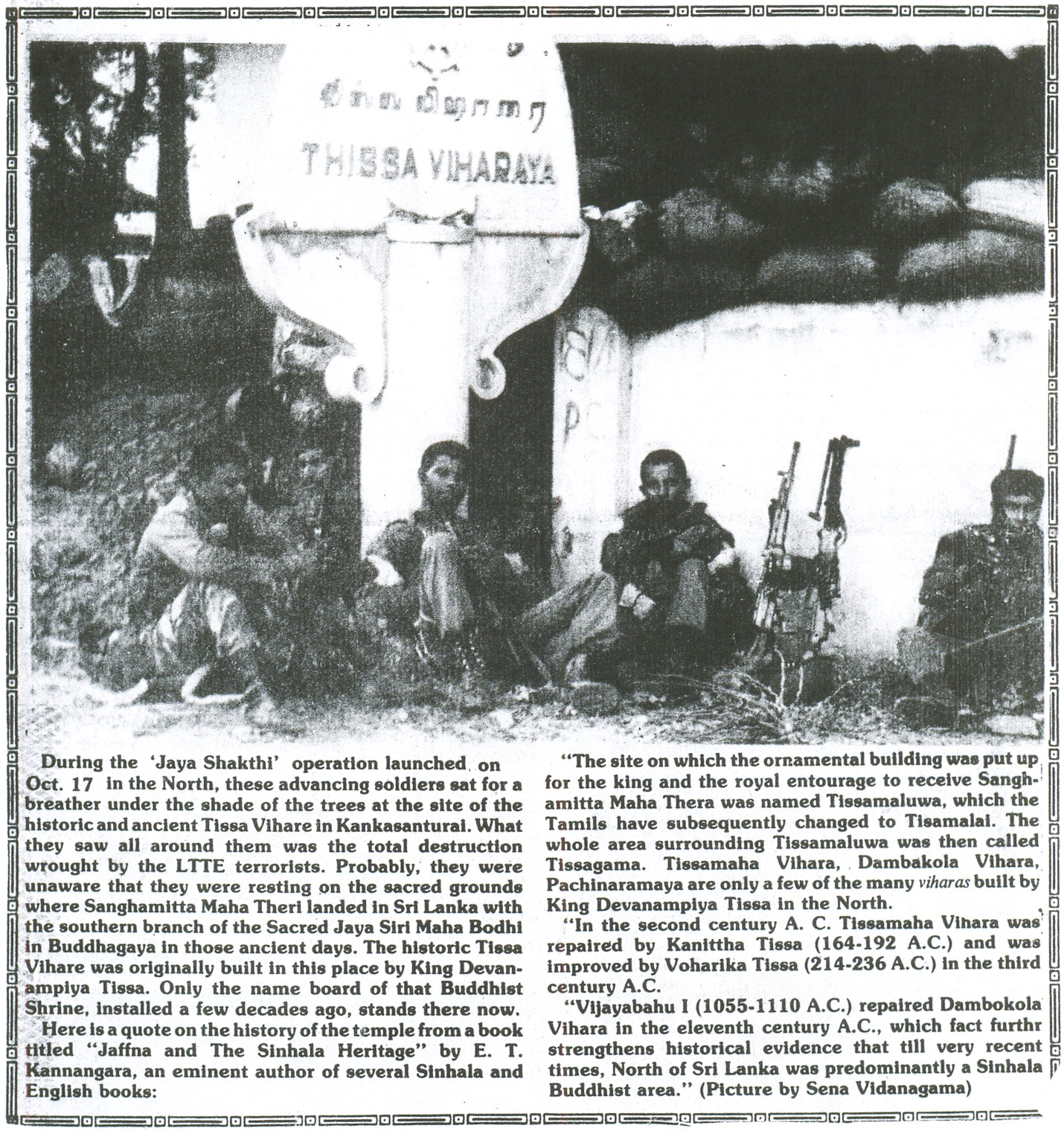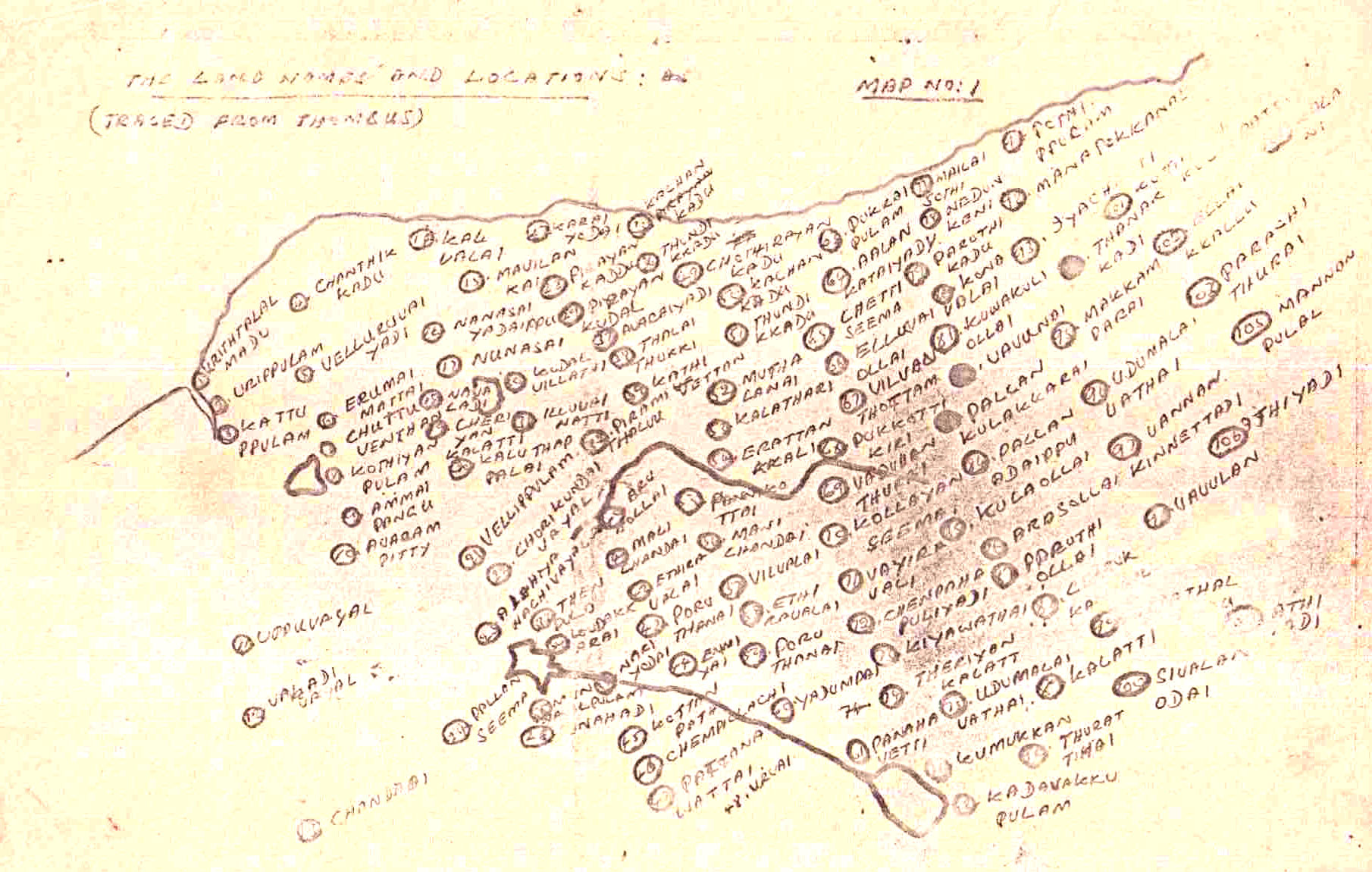Traditions on the Tissanayagam family and the viallage of Mathakal.
Tradition 1
Tissayan or Ticaiyan was a title every male member of the clan carried as a prefix to his name. The family took great pride in this title as an important part of their heritage.
During a wedding ceremony of the male member of the clan, the officiating priest would always use the prefix Tissayan to the names of the groom and his ascendants when reciting the "gothra" (pedigree)
It was for this reason that Mr. M. J Tissanayagam, when he was on the editorial staff of the Ceylon Daily News, in the 1950s assumed the pen name Tissayan, when writing his column.
The narrator is not aware of the actual significance of this name, however the following information may be of relevance.
1.1 Paranawithana in his introduction to the "Inscriptions of Ceylon" states under a section captioned "Royal Titles" that Tissaya was a name made up of two words; Tissa and Aya. He goes onto to state that the sons of kings were referred to with the title "Aya". The use of the word in connection with Royal Princes is paralleled by that of "Kumara" which has the meaning of child.
He also explains that "Daraka" was another title for a Prince which once again in Sanskrit and Pali means Daru or child. Giving reasons he comes to the conclusion that unlike a Prince with the title Aya who could transmit his Royal status to his descendants a Prince with the title "Daraka"was not in a position to do so.
Source – Inscriptions of Ceylon by Paranavitana, Introduction - pages XV to XVIII
1.2 Ragupathi in his book "Early Settlements of Jaffna" refers to Ticayan as an ancient clan name
Source – Early settlements of Jaffna by P. Ragupathy, page 223 (notes to chapter 5. note 12) Chapter 5 covers the area called Ticaimaluvai (Tissamaluwa in the Mahavamsa), near Mathakal from where the family originates.
1.3 Tissanayagam literally means Nayaka or Chief of the Tissa clan.
Originally the family spelt its name as Tissainaygam as it made more sense in the Tamil language. Tissai means direction and hence "Tissainayagam meaning lord of all directions". However in all of the old documents the name in Tamil has been spelt as
Contrary to popular belief the name Tissanayagam or Tissainaygam is not the Tamil equivalent of the Sinhala name Disanayaka.
Tradition 2
According to local tradition, Sangamitta theri disembarked with the branch of the sacred Sri Maha Bhodi tree from Gaya, on a land belonging to the family, which carries the thomboo name of Pothipulam (the land of the Bodhi) and was situated on the beach in Mathakal. This seven acre property which was the last piece of land owned by the family in Mathakal was acquired by the Sri Lanka Army and converted to the Mathakal Army Camp.
Many historians and archaeologists have identified Sambu Thurai which is in close proximity to Mathakal as the ancient port of Jambukola
| Refer: |
Ancient Jaffna by C Rasanayagam (pages 62-65)
Early Settlements of Jaffna by P. Ragupathy (page 50)
Tamil Culture in Ceylon by M. D. Ragavan (pages 62-63)
|
According to Ragavan, Sambu Thurai gets it name, as there arrived at this port an image of Sambu (an Epithet for Siva in his manifestation as "He who grants boons").
He adds that this port finds mention in Sinhala chronicles as Jambukola where landed the sacred Bo tree. There is also the tradition that here was received a stone image of Parvati, reminiscent of which is its alternate name "Matha-kal" literally "stone–mother" simplified to Mathakal. This shows that Jambukola and Mathagal refer to the same geographic location or are in close proximity to each other.
Ragavan in his book Tamil culture in Ceylon, mentions that there is a tradition in the Karava community of Mathakal, that their ancestors came to Sri Lanka navigating the boats that had brought Sangamitta Theri to Ceylon.
Tradition 3
There is also a land near Mathakal which bears the Thomboo name Tissa-Maluwa which corroborates the Mahawamsa story which states that King Devanampiya Tissa received the Bo tree on a land bearing the same name. This land which was subsequently called Tissa gama is now known as Tissa Malai to the Tamils of the area.
The Mahavamsa states that Tissa Vihara was built on this site where Sangamitta landed. The army built a Vihara at Pothipulam within the compound of the Mathakal Army camp in the 1970s, which was mistakenly named Tissa Vihara. This was demolished by the LTTE after the riots of 1983, however a new Vihara named Dambakola Vihara has now been builot by the government in the vicinity.

| Source: |
Daily News of 28th October 1990
Ancient Jaffna by C. Rasanayagam (page 64)
Mahavamsa
|
Tradition 4
According to family tradition a Jaffna princess was given in marriage to an Ancestor of Tissanayake Mudali. This tradition was also current in the village of Mathakal, and was confirmed when a scholar named Shanthikumar (attached to the MARGA Institute) was conducting research on Sociology in 1980's.
As mentioned previously some of the thombu names of the lands owned by Tissa Nayaka Mudali either had Royal connotations or a connotations linking it to a Matriarch. His principal residence was named Mannanpulam around which arrayed lands with names that denoted settlement of services caste (refer)

There were also two other lands one named "Alahiya Nachier Vayal" which reads the field of the beautiful noble woman / princess. And "Ammai Pangu" which reads dower or portion of the Matriarch.
The Yalpana Vaipava Malai states that Princess Vetha Valli the daughter of the last King of Jaffna was given in marriage to a Vellala Chieftan from Mathakal. Even though the story itself may not be a verbatim account of history, in relation to the names and chronology etc…, it may have been madeup to corroborate a local tradition.
| Refer: |
Yalpana Vaipavamalai by K. Sabanathan
Yalpana Vaipavamalai by C. Britto (page 47)
|
Tradition 5
The clan believes that they belong to the Kalinga line of Jaffna
According to the Vaipava Malai, Ugrasingha of Kalinga a descendant of King Vijaya's brother boldly carried away princess Maruthap-pira-vika-villi as he was struck by her beauty. The princess was in the process of building a temple at Maviddapuram with the help of her father Thisai Yukkra Chola. It is interesting to note that the latter carried a prefix similar to that of the clan. Ugra singhe and Maruthap-pira-vika-villi founded the Kalinga line of Jaffna.
Refer Yalpana Vaipava Malai – pages 9-10, 11-13
Tissanayake Mudali's son Vishwanathan was the Udayar of Maviddapulam. A document where he has signed as a witness to a marriage which took place in 1791, is available in the family archives.
Maviddapulam was the seat of Hindu Orthodoxy and its temple perhaps one of the oldest and premier temples of the peninsula. Referred to as the temple of the 7 pagoda's it was destroyed by the Portugese in the 1770's. To have been the Udayar of Maviddapuram, Tissanayake Mudaliyar Vishvanathan should have come from an exceptionally high caste.
According to tradition the Arya Chakravarthi's who came to Jaffna in the 13th century, married into the old Kalinga line "Gangei Kula" of Ceylon to gain legitimacy and acceptance. It was for this reason perhaps that the Arya Chakravarthi's who were originally of the "Arya kula" styled themselves "Gangei Arya".
source: Tamil Culture by Ragawan pages 71, 74-76
Tradition 6
Family tradition also held that the clan was closely aligned by marriage to the families of the chieftans of the North Central Province, such as the Bulankulame's; Nuwarawewa's etc... To corroborate this there is the grant of Nallamapaanan the Vannian of Pannankamam which dates back to Dutch times. This grant appoints Kantha Udayan of Vilamkulam as mudaliyar of Kilakku Mulai. On appointment Kantha Udayan takes the name of Ticai Vilangu Nayakka Mudali.
Vilamkulam literally translates to Wood-apple pond (or pond by the wood-apple trees) Bulankulame is a Sinhala corruption of this same name. Hence Kantha Udayan who took the name of Ticai Vilanga Nayakka Mudali was most probably a scion of the Bulankulame family and also an ancestor of Tissanayake Mudali.
It is interesting to note that there is another Anuradhapura family who called themselves Maha-Divul-Wewa which again is a direct Sinhala translation of the same name.
The Bulankulame family who were the custodians of the Bo tree, claim that their ancestor was the maternal uncle of Sangamiththa theri and came to Lanka with along with her. According to the traditions of the Tissanayagam family and the traditions of the village of Mathakal there were many matrimonial alliances between the family and the families of the North Central province Vannier Chieftans. The famous Vannian Kovil or temple in the village perhaps corroborates this tradition.
As mentioned previously not only was there a strong family tradition that the Bo tree landed and was received on land belonging to the clan, but also a tradition in the village that Sangamiththa arrived there.
Tradition 7
Although the existence of the Mahavamsa was only discovered in the early twentieth century, the legend recording the early colonization of Lanka and the coming of Wijaya was widely known throughout the island. It was even known to the Tamils if the North. The Vypavamalai which sets down the legends and history of the Northern Kingdom, which was written during Dutch times begins with this Legend. (this was long before Gieger discovered the Mahavamsa)
Some historians believe that Vijaya landed near Keerimalai in close proximity to Mathakal. The following adds credence to this belief
This area is one of the places in Sri Lanka where copper coloured soil (loam) is found in close proximity to the coast. According to the Mahavamsa Vijaya and his followers kissed the soil as they landed on the Island. The red loam where they knelt down turned their palms to a copper colour, as a result of which they names the island "Tambapani"
| Refer: |
Mahavamsa's story as to why the country was named Tambapani which literally meant copper coloured palms.
Rasanayagam
Ragavan (page 56)
|
Mathakal is the only area in Sri Lanka where there are underground caverns in close proximity to the coast. According to the Mahavamsa, Vijaya's followers after disembarking on Lankan soil went in search of water, and were lured to an underground cavern where they were kept prisoner by the Yakshayas. When Vijaya went in search of them he was led to a cavern where Kuveni the Yakshini sat spinning at a wheel. This once again reinforces the popular belief that Wijeya landed near Mathakal or Keeri malai.
Some Etymologists have come up with the theory that the name Yapane (Jaffna) is derived from the two words Yaha (which means good) and Pane (which means water) as a result of the fresh water springs at Keerimalai. Keerimalai was a port where sailing ships called at for the supply of drinking water. There is also a school of thought that the actual meaning of Tambapani is not red palms but excellent water (In Sanskrit Tamara means water)
Dambakola (Sambilthurai) means Damba(rock) and Kula means pond which perhaps again refers to the famous springs at Keerimalai, which is in the proximity to Mathakal.
Tradition 8
It was accepted within the family, that Tissanayake Mudali had a brother named either Wickremasinghe Mudaliyar or Weerasundera Mudaliyar. (source: Emily Alagamma Tissanayagam Selvaratnam)
Note: There is a Wickremasinghe Mudali mentioned in the Madhagal Thombus and the Yalpana Viabava Kaumudi However his connection to Tissanayake Mudali has not been established. The thombu's of Mathakal have been certified as correct by this same Wickremasinghe mudaliyar.
Tissayan is the Tamil equivalent of Tissaya. Hence it is possible that the clan was a royal one descended from a progenitor named Tissa. The name Tissanayaka, or Tissanayagam means the Nayaka or Chief of the Tissa clan.